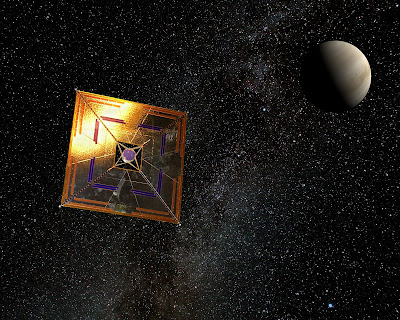 |
| Artist’s depiction of a space probe, propelled by a solar sail. (Image credit: Andrzej Mirecki) |
Topics: Exoplanets, Interstellar Travel, NASA, Space, Space Exploration, Spaceflight, Spacetime
Solar sails have been discussed for a long time as the most viable option for interstellar travel at current technological attainment. That will entail the nanoengineering of polymers that can be durable to things like micro-meteor strikes at 0.1 c (one-tenth the speed of light) as well as shielding for electronics so as not to fry instrumentation on the exceedingly long journey. I hope we're mature enough societally, socially and emotional intelligence-wise to complete the project. It would be a shame if our instrument transmitted information back to Mother Earth, and for a myriad of bad reasons, no one was here to receive the message.
NASA is in the earliest stages of planning an exoplanet expedition, set to mark the 100th anniversary of its first crewed Moon landing, Apollo 11. A small team based at the Jet Propulsion Laboratory (JPL) hopes to send a spacecraft to a distant planet in search of life.
In 2016, a funding bill was passed that called upon NASA to investigate methods of interstellar travel that could reach at least 10 percent of the speed of light by 2069 [the 100th year anniversary of the Apollo 11 mission]. It also requested a mission to Alpha Centauri, the closest star system to our own.
A probe is set to be sent to the chosen exoplanet to determine whether or not life is present. A few years after its launch, NASA will send a large telescope into deep space, which will use gravitational lensing to offer a full view of the exoplanet.
At present, there’s some debate as to whether Alpha Centauri or another system will be selected, as there are several candidates being considered. Of course, there are some big questions to be answered before this mission becomes a reality.
NASA Is Planning the First-Ever Interstellar Mission, Brad Jones, Futurism
#P4TC:
Comments